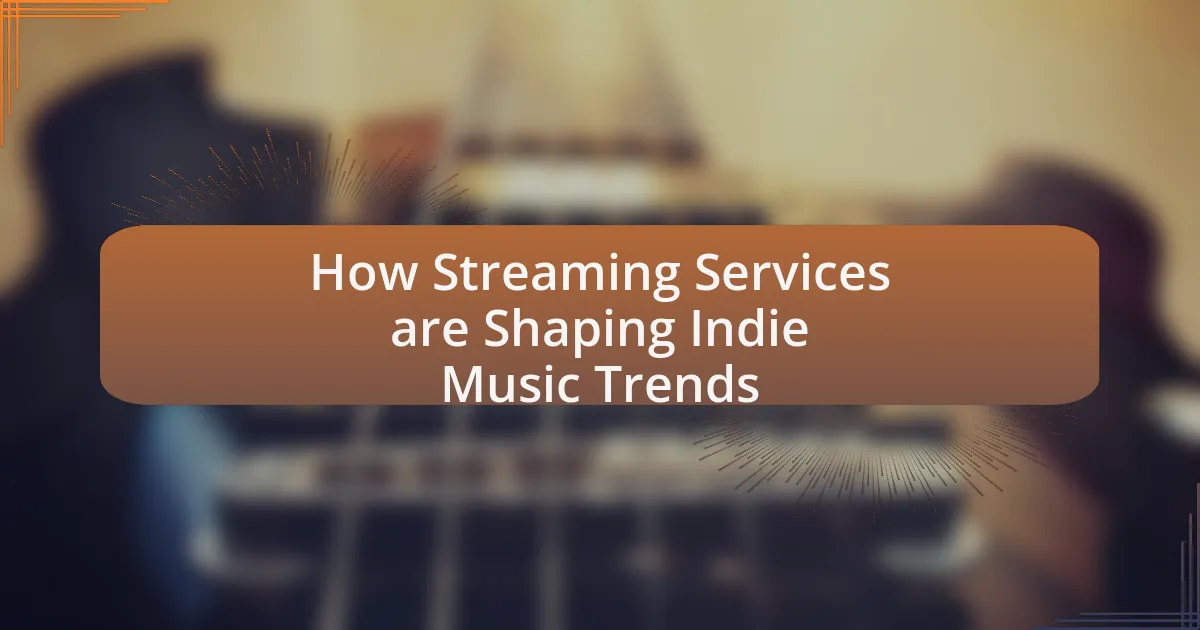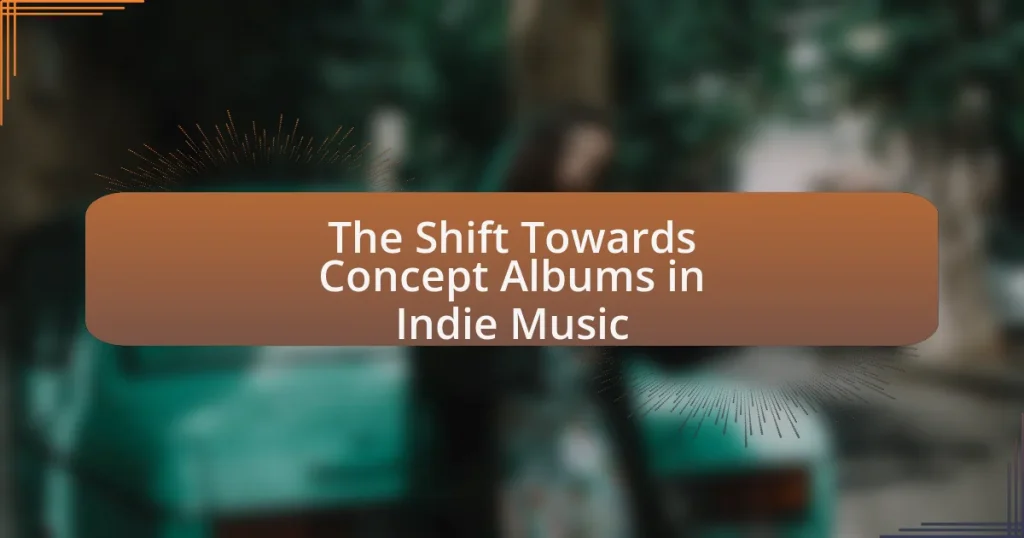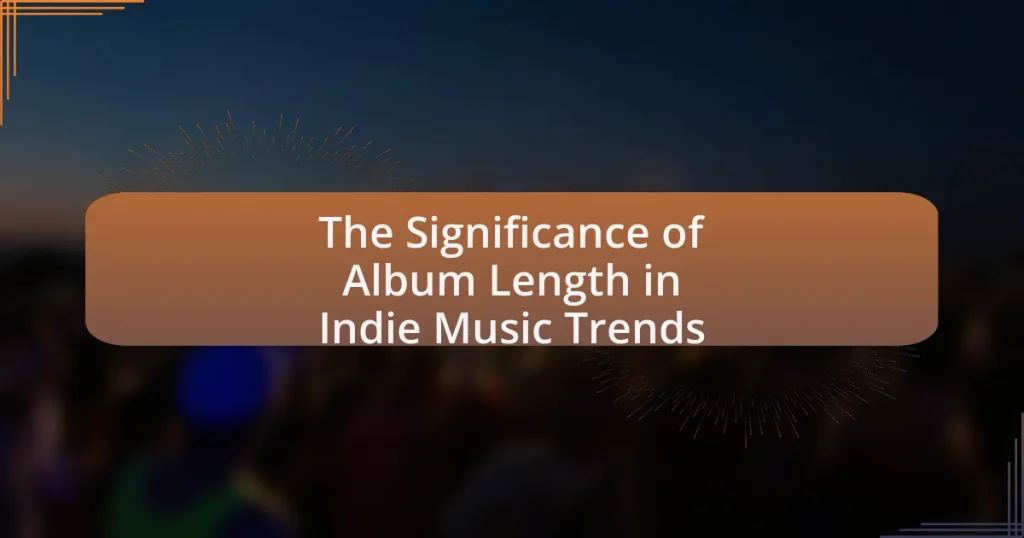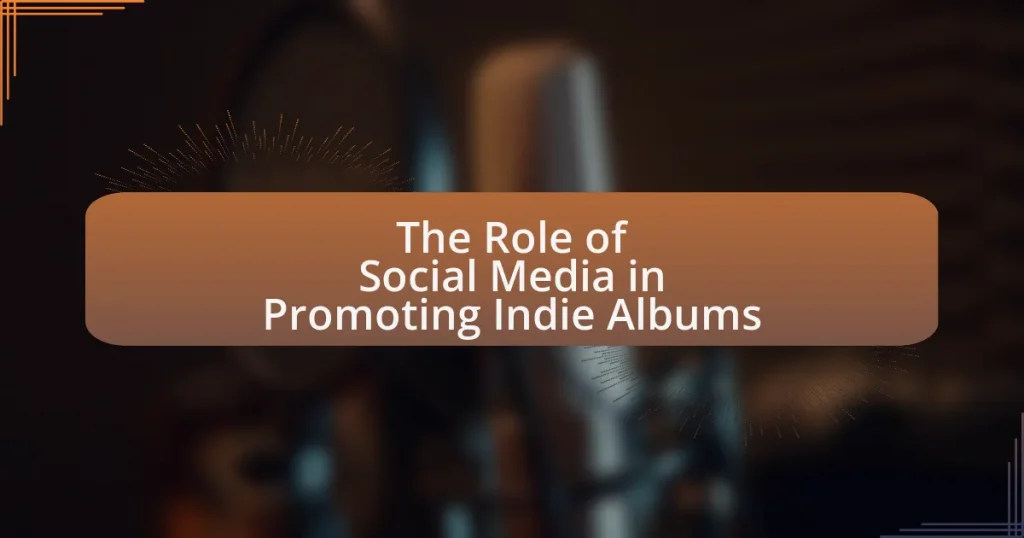Streaming services are fundamentally reshaping indie music trends by providing independent artists with direct access to global audiences and valuable data insights. Platforms like Spotify and Apple Music facilitate widespread music distribution without the constraints of traditional record labels, resulting in significant revenue growth for indie musicians. The article explores how algorithms enhance the discovery of indie artists, the impact of curated playlists on music popularity, and the challenges faced by these musicians in a competitive streaming landscape. Additionally, it examines the evolving relationship between streaming services and indie labels, highlighting strategies for artists to optimize their presence and maximize revenue on these platforms.
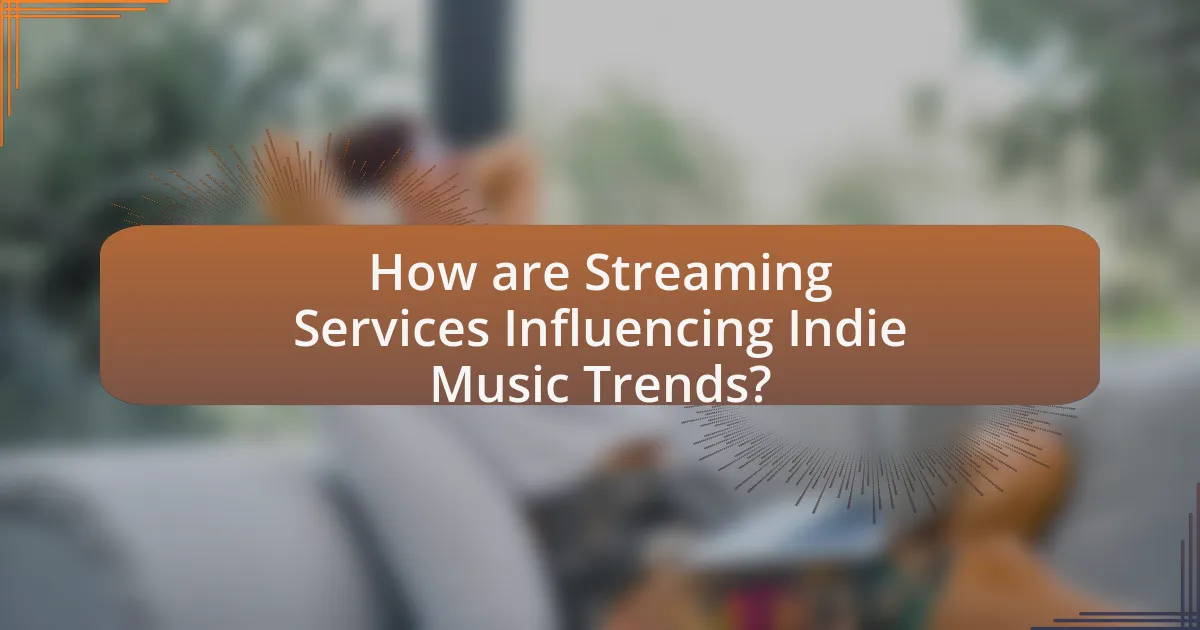
How are Streaming Services Influencing Indie Music Trends?
Streaming services are significantly influencing indie music trends by providing artists with unprecedented access to global audiences and data-driven insights. These platforms, such as Spotify and Apple Music, allow independent musicians to distribute their music widely without the need for traditional record labels, which historically controlled access to mainstream audiences. According to a report by MIDiA Research, indie artists saw a 35% increase in streaming revenue from 2019 to 2020, highlighting the financial benefits of these platforms. Additionally, streaming services utilize algorithms that promote emerging indie artists based on listener preferences, further shaping trends by elevating diverse sounds and styles that may not have received attention through conventional channels. This democratization of music distribution and promotion is reshaping the landscape of the indie music scene.
What role do streaming platforms play in the discovery of indie artists?
Streaming platforms significantly enhance the discovery of indie artists by providing accessible distribution channels and personalized recommendation algorithms. These platforms, such as Spotify and Apple Music, allow indie musicians to upload their music without the need for traditional record labels, thereby reaching a global audience. According to a 2021 report by the International Federation of the Phonographic Industry, over 60% of music listeners discover new artists through streaming services, highlighting their pivotal role in artist exposure. Additionally, curated playlists and algorithm-driven suggestions increase the likelihood of indie artists being featured alongside mainstream acts, further amplifying their visibility and listener engagement.
How do algorithms affect the visibility of indie music?
Algorithms significantly enhance the visibility of indie music by curating personalized playlists and recommendations for listeners. Streaming platforms like Spotify and Apple Music utilize complex algorithms that analyze user behavior, preferences, and listening history to promote indie artists to targeted audiences. For instance, Spotify’s Discover Weekly playlist, which features new music tailored to individual users, has been shown to increase streams for lesser-known indie tracks, leading to a 30% rise in plays for featured songs. This targeted exposure allows indie musicians to reach potential fans who may not have discovered their music otherwise, thereby expanding their audience and increasing their chances of success in a competitive market.
What impact do playlists have on indie music popularity?
Playlists significantly enhance the popularity of indie music by providing curated exposure to a wider audience. Streaming platforms like Spotify and Apple Music feature playlists that often include indie tracks, which can lead to increased streams and listener engagement. For instance, a study by the University of Southern California found that songs featured on popular playlists can experience a 200% increase in streams within a week of being added. This exposure not only boosts individual song performance but also elevates the overall visibility of indie artists, contributing to their growth in the music industry.
Why are indie artists turning to streaming services for distribution?
Indie artists are turning to streaming services for distribution primarily due to the accessibility and reach these platforms provide. Streaming services like Spotify and Apple Music allow independent musicians to distribute their music globally without the need for traditional record label support. This democratization of music distribution enables indie artists to connect with a wider audience, as evidenced by the fact that over 60% of music consumption in the U.S. now occurs through streaming platforms, according to the Recording Industry Association of America (RIAA). Additionally, these services often offer data analytics that help artists understand their audience better, further enhancing their marketing strategies and engagement efforts.
What advantages do streaming services offer over traditional distribution methods?
Streaming services provide greater accessibility and convenience compared to traditional distribution methods. Users can instantly access a vast library of music from anywhere with an internet connection, eliminating the need for physical media or specific locations to purchase music. According to a report by the Recording Industry Association of America (RIAA), streaming accounted for 83% of the U.S. music industry’s revenue in 2020, highlighting its dominance over traditional sales. Additionally, streaming platforms often offer personalized recommendations and playlists, enhancing user engagement and discovery of indie artists, which traditional methods struggle to match.
How do streaming services help indie artists reach global audiences?
Streaming services enable indie artists to reach global audiences by providing a platform for their music to be distributed widely without the need for traditional record labels. These platforms, such as Spotify and Apple Music, offer algorithms that promote music based on listener preferences, allowing indie artists to be discovered by users worldwide. For instance, Spotify’s editorial playlists and personalized recommendations can significantly increase an artist’s visibility, leading to millions of streams and potential fan engagement. Additionally, data analytics provided by these services help artists understand their audience demographics and tailor their marketing strategies effectively.
What challenges do indie musicians face on streaming platforms?
Indie musicians face significant challenges on streaming platforms, primarily including low revenue from streams, lack of visibility, and difficulties in audience engagement. The revenue model of streaming services often pays artists fractions of a cent per stream, making it difficult for indie musicians to earn a sustainable income; for instance, Spotify reportedly pays between $0.003 and $0.005 per stream. Additionally, the sheer volume of content on these platforms leads to fierce competition, resulting in many indie artists struggling to gain visibility amidst established acts. Furthermore, engaging with audiences can be challenging due to algorithm-driven playlists that favor popular tracks, limiting the chances for lesser-known artists to be discovered. These factors collectively hinder the growth and financial viability of indie musicians in the streaming landscape.
How does revenue distribution work for indie artists on these platforms?
Revenue distribution for indie artists on streaming platforms typically involves a percentage of the revenue generated from streams being allocated to the artists. For example, platforms like Spotify and Apple Music pay artists based on the number of streams their music receives, with the average payout per stream ranging from $0.003 to $0.005. This means that indie artists earn a fraction of a cent for each stream, and the total revenue is divided among rights holders, including record labels, producers, and songwriters. Additionally, many platforms require artists to distribute their music through aggregators, which may take a cut of the revenue, further impacting the amount indie artists receive.
What barriers exist for new indie artists in the streaming landscape?
New indie artists face several barriers in the streaming landscape, primarily including limited visibility, financial constraints, and algorithmic challenges. Limited visibility arises because major playlists and promotional opportunities are often dominated by established artists, making it difficult for newcomers to gain traction. Financial constraints impact indie artists as they may lack the resources for marketing and production, which are essential for standing out in a crowded market. Algorithmic challenges occur when streaming platforms prioritize popular tracks, further marginalizing new artists who struggle to be featured prominently. According to a 2021 report by the Music Industry Research Association, over 70% of new releases do not receive significant playlist placements, highlighting the competitive disadvantage faced by indie musicians.
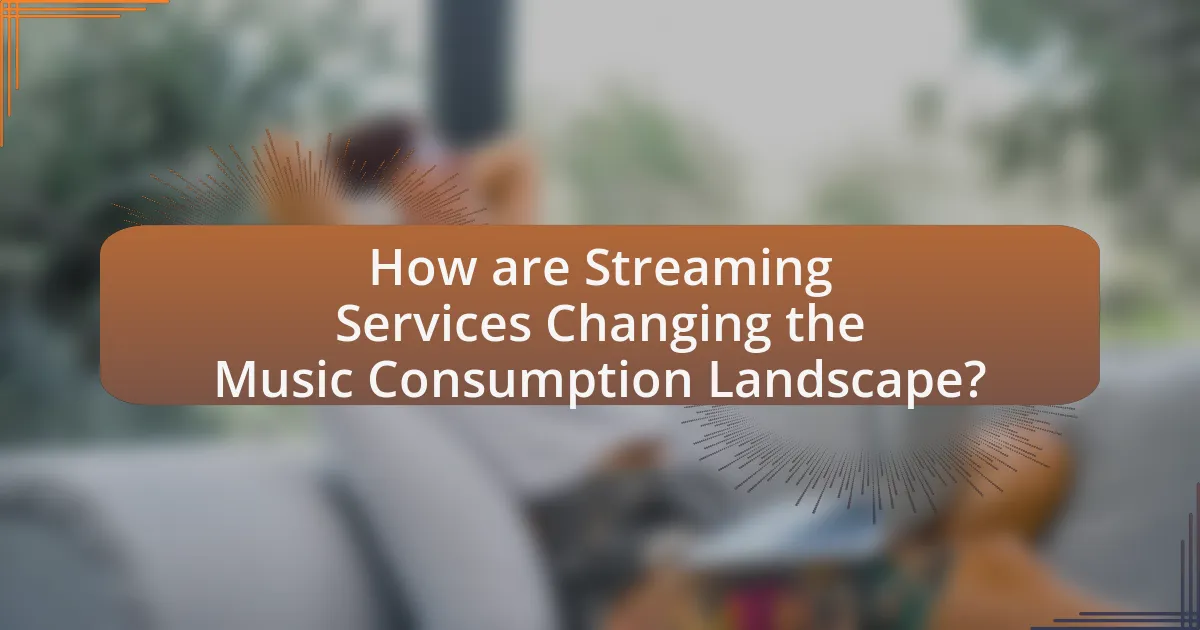
How are Streaming Services Changing the Music Consumption Landscape?
Streaming services are transforming the music consumption landscape by providing instant access to vast libraries of music, which has significantly altered how listeners discover and engage with music. These platforms, such as Spotify and Apple Music, allow users to stream millions of songs on-demand, leading to a decline in physical album sales and digital downloads. According to the Recording Industry Association of America (RIAA), streaming accounted for 83% of the U.S. music industry’s revenue in 2021, highlighting its dominance over traditional formats. Additionally, algorithms and curated playlists on these services enhance music discovery, enabling indie artists to reach wider audiences without the need for traditional marketing channels. This shift has democratized music access, allowing diverse genres and emerging artists to gain visibility and traction in a competitive market.
What trends are emerging in music consumption due to streaming services?
Emerging trends in music consumption due to streaming services include increased accessibility, personalized listening experiences, and a shift towards single-track releases over full albums. Streaming platforms like Spotify and Apple Music have made vast music libraries available to users, allowing listeners to discover a wider range of genres and artists, particularly in the indie music scene. Personalized algorithms curate playlists based on individual listening habits, enhancing user engagement and promoting lesser-known artists. Additionally, the focus on singles aligns with consumer preferences for shorter, more digestible content, as evidenced by the rise in popularity of tracks over traditional album formats. This shift is supported by data showing that single releases have outpaced album sales in recent years, reflecting changing consumer behaviors in music consumption.
How has listener behavior shifted with the rise of streaming?
Listener behavior has shifted significantly with the rise of streaming, leading to increased consumption of music on-demand and a preference for curated playlists. This change is evidenced by the fact that, according to a 2021 report from the Recording Industry Association of America (RIAA), streaming accounted for 83% of the U.S. music industry’s revenue, indicating a clear shift from traditional purchasing methods like CDs and downloads. Additionally, listeners now favor discovering new music through algorithm-driven recommendations and playlists, which has altered how artists promote their work and engage with audiences.
What demographic changes are evident in indie music listeners?
Indie music listeners are increasingly diverse, with notable demographic shifts towards younger audiences and a growing representation of women and non-binary individuals. Recent studies indicate that approximately 60% of indie music listeners are under the age of 30, reflecting a trend where streaming platforms like Spotify and Apple Music have made indie genres more accessible to younger demographics. Additionally, data from the 2022 Music Industry Report shows that female and non-binary listeners now comprise nearly 50% of the indie music audience, a significant increase from previous years. This shift highlights the evolving landscape of indie music, driven by the inclusive nature of streaming services that promote a wider array of artists and genres.
Why is the relationship between streaming services and indie labels important?
The relationship between streaming services and indie labels is important because it enables independent artists to reach wider audiences and gain visibility in a competitive market. Streaming platforms like Spotify and Apple Music provide indie labels with essential distribution channels that were previously dominated by major labels, allowing for greater diversity in music offerings. According to a 2021 report by the International Federation of the Phonographic Industry, independent labels accounted for 40% of global recorded music revenue, highlighting their significant role in the industry. This collaboration fosters innovation and creativity, as indie labels often prioritize artistic expression over commercial viability, enriching the overall music landscape.
How do streaming services collaborate with indie labels to promote artists?
Streaming services collaborate with indie labels to promote artists by providing curated playlists, algorithm-driven recommendations, and marketing support. These platforms often feature indie artists prominently in playlists that attract millions of listeners, significantly increasing their visibility. For instance, Spotify’s “Fresh Finds” playlist is dedicated to showcasing emerging indie talent, which has led to notable success stories for featured artists. Additionally, streaming services may offer promotional tools and data analytics to indie labels, enabling them to target specific audiences effectively. This collaboration not only enhances the reach of indie artists but also enriches the streaming service’s content diversity, benefiting both parties.
What strategies do indie labels use to leverage streaming platforms?
Indie labels leverage streaming platforms through targeted marketing, playlist placements, and data analytics. Targeted marketing involves using social media and digital advertising to reach specific audiences, enhancing visibility and engagement. Playlist placements are crucial, as being featured on popular playlists can significantly increase streams and exposure; for instance, tracks on Spotify’s “Discover Weekly” can see a surge in listeners. Data analytics allows indie labels to track listener behavior and preferences, enabling them to tailor their strategies effectively. According to a 2021 report by MIDiA Research, indie labels have seen a 30% increase in revenue from streaming, highlighting the effectiveness of these strategies.
What future trends can we expect in indie music due to streaming services?
Future trends in indie music due to streaming services include increased accessibility for artists and a shift towards data-driven marketing strategies. Streaming platforms enable independent musicians to reach global audiences without traditional gatekeepers, leading to a rise in diverse sounds and genres. Additionally, artists are increasingly utilizing analytics provided by these services to tailor their promotional efforts, enhancing engagement with listeners. According to a report by MIDiA Research, indie artists saw a 35% increase in revenue from streaming in 2022, highlighting the financial viability of this model. This trend suggests that as streaming continues to evolve, indie music will likely become more prominent and commercially successful.
How might technology further influence indie music distribution?
Technology will further influence indie music distribution by enhancing accessibility and streamlining the distribution process. Innovations such as blockchain technology can provide transparent royalty tracking, ensuring artists receive fair compensation for their work. Additionally, advancements in artificial intelligence can help indie musicians analyze listener data to tailor their marketing strategies effectively. According to a report by MIDiA Research, 70% of independent artists are now using digital distribution platforms, which have grown significantly due to technological advancements, allowing for wider reach and easier access to global audiences.
What role will social media play in the future of indie music streaming?
Social media will play a crucial role in the future of indie music streaming by serving as a primary platform for artist promotion and audience engagement. As indie artists increasingly rely on social media to share their music, build fan communities, and connect directly with listeners, platforms like Instagram, TikTok, and Twitter facilitate viral marketing and grassroots support. For instance, TikTok has been instrumental in propelling indie tracks to mainstream success, with songs like “Roxanne” by Arizona Zervas gaining millions of streams after viral challenges. This trend indicates that social media not only enhances visibility for indie musicians but also drives streaming numbers, making it an essential tool for their growth and sustainability in the music industry.
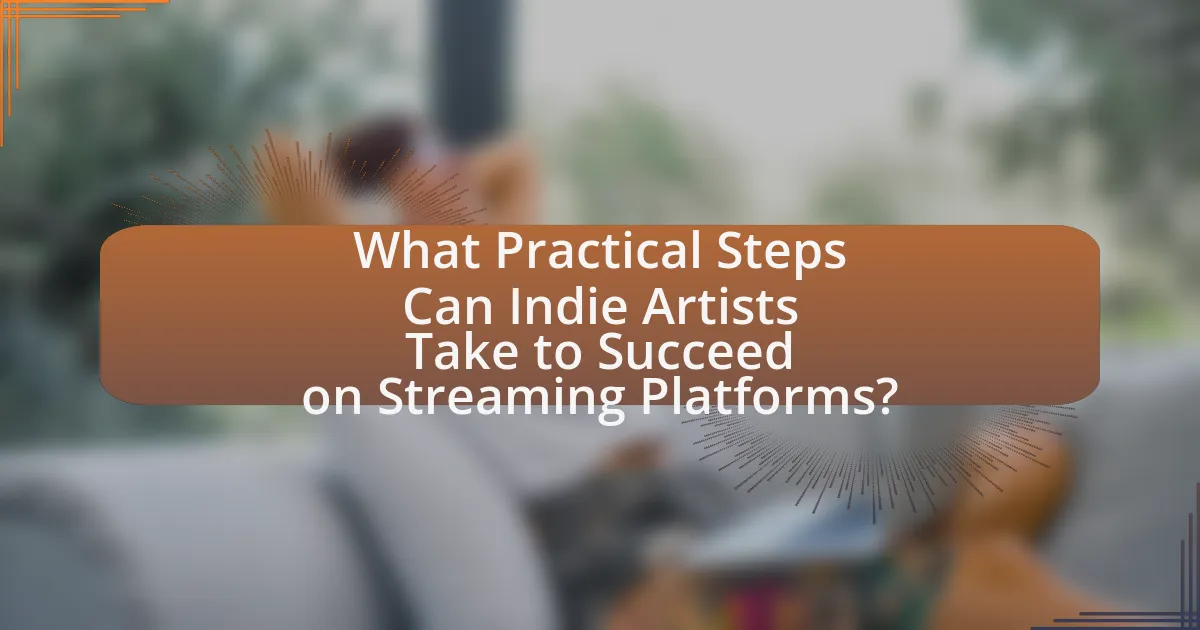
What Practical Steps Can Indie Artists Take to Succeed on Streaming Platforms?
Indie artists can succeed on streaming platforms by actively promoting their music, engaging with their audience, and utilizing data analytics. Promoting music through social media channels and collaborations increases visibility; for instance, artists who engage with fans on platforms like Instagram and TikTok often see higher streaming numbers. Engaging with the audience through live streams and Q&A sessions fosters a loyal fan base, which is crucial for sustained success. Additionally, utilizing data analytics tools provided by streaming services helps artists understand listener demographics and preferences, allowing them to tailor their marketing strategies effectively. According to a report by MIDiA Research, independent artists who leverage these strategies can increase their streaming revenue by up to 30%.
How can indie artists optimize their presence on streaming services?
Indie artists can optimize their presence on streaming services by utilizing effective marketing strategies, engaging with their audience, and leveraging data analytics. By promoting their music through social media platforms and collaborating with influencers, artists can increase their visibility. Engaging directly with fans through live streams and Q&A sessions fosters a loyal community. Additionally, analyzing streaming data helps artists understand listener preferences, allowing them to tailor their releases and marketing efforts accordingly. According to a report by MIDiA Research, artists who actively engage with their audience on social media see a 30% increase in streaming numbers, demonstrating the effectiveness of these strategies.
What strategies should artists use for playlist placements?
Artists should focus on building relationships with playlist curators to enhance their chances of playlist placements. Establishing connections through social media, attending industry events, and engaging with curators’ content can create opportunities for artists to showcase their music. Additionally, artists should ensure their music is of high quality and aligns with the genre and mood of the playlists they target, as playlists often have specific themes. Data from Spotify indicates that tracks featured on playlists can receive up to 10 times more streams than those not included, highlighting the importance of strategic placements.
How can social media be effectively integrated with streaming efforts?
Social media can be effectively integrated with streaming efforts by utilizing targeted promotional campaigns that engage audiences across platforms. For instance, artists can share exclusive content, such as behind-the-scenes footage or live Q&A sessions, on social media to drive traffic to their streaming profiles. According to a study by Nielsen, 70% of music listeners discover new music through social media, highlighting the importance of these platforms in reaching potential fans. Additionally, leveraging user-generated content, such as fan covers or remixes, can create a sense of community and encourage sharing, further amplifying streaming efforts.
What common mistakes should indie artists avoid on streaming platforms?
Indie artists should avoid neglecting their promotional strategies on streaming platforms. Many indie musicians mistakenly believe that simply uploading their music will lead to success, but without active promotion, their work may go unnoticed. According to a study by the Music Industry Research Association, 70% of independent artists report that effective marketing significantly impacts their streaming numbers. Additionally, failing to engage with listeners through social media and not utilizing playlist placements can hinder their visibility. Therefore, indie artists must prioritize marketing efforts and audience engagement to maximize their reach on streaming platforms.
How can artists ensure they are maximizing their revenue from streams?
Artists can maximize their revenue from streams by strategically promoting their music across multiple platforms and engaging with their audience. Utilizing social media effectively can increase visibility and drive traffic to streaming services, where artists earn revenue per stream. Additionally, artists should consider releasing exclusive content or merchandise tied to their music to create additional revenue streams. According to a 2021 report by the International Federation of the Phonographic Industry, artists who actively engage with fans on social media platforms see a 30% increase in streaming revenue compared to those who do not. This demonstrates that a proactive approach in promotion and fan interaction directly correlates with higher earnings from streaming services.
What pitfalls should artists be aware of when promoting their music online?
Artists should be aware of several pitfalls when promoting their music online, including oversaturation, ineffective targeting, and neglecting engagement. Oversaturation occurs when artists flood platforms with content, making it difficult for individual tracks to stand out; for instance, over 40,000 songs are uploaded to Spotify daily, creating fierce competition. Ineffective targeting can lead to wasted resources, as artists may promote their music to audiences that do not align with their genre or style, resulting in low engagement rates. Additionally, neglecting engagement with fans can diminish loyalty and interest; studies show that artists who actively interact with their audience see a 30% increase in fan retention. These pitfalls can significantly hinder an artist’s ability to successfully promote their music online.
